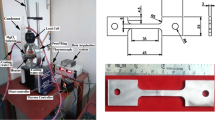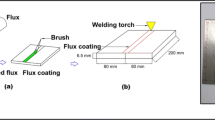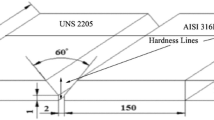Abstract
In this study, 6 mm thick duplex stainless-steel grade 2205 plate was welded by active tungsten inert gas (ATIG) using different oxide fluxes and the effect of optimal oxide fluxes on structure, mechanical and corrosion properties was systematically analyzed and discussed. Initially, fourteen oxides were tested (SiO2, TiO2, ZnO, MnO2, Cr2O3, Fe2O3, ZrO2, SrO, CaO, MoO3, V2O5, Mn2O3, Co2O3 and MgO). Among these, three candidate oxides, i.e., SiO2, Ti2O and ZnO were selected for further evaluation based on the depth ratio, depth-to-width (D/W), and ultimate tensile strength (UTS) results. By using Minitab 17 software, optimal combinations of these fluxes for maximum penetrations were estimated. The obtained results revealed that the optimal flux composition is 76 % SiO2-24 % ZnO. The results showed that the depth attained by the optimized flux is 2.9 times greater than tungsten inert gas (TIG) weld. The D/W ratio was also improved 3.7 times when contrasted with typical TIG welding. The energy absorbed in fusion zone in the case of ATIG weld is greater when contrasted with TIG weld. It was found that the weld bead obtained with optimal flux combination in ATIG weld can better withstand sudden loads. The obtained UTS value (810 MPa) for ATIG weld was close to parent metal (825 MPa) and greater than the weld produced by TIG welding (766 MPa). However, the corrosion resistant property was found to be slightly decreased for metal welded with ATIG as compared to metal welded by using TIG. These results give a comprehensive guideline for further investigations on TIG welding of 2205 duplex stainless-steel.
Similar content being viewed by others
References
J. Nowacki, Duplex-steel welding problems in the building of chemical cargo ships, Weld. Int., 18 (2004) 509–515.
J. Nowacki and Z. Piotr, Mechanical properties of duplex steel welded joints in large-size constructions, Weld. Int., 26 (2012) 424–435.
T. H. Chen and J. R. Yang, Effects of solution treatment and continuous cooling on σ-phase precipitation in a 2205 duplex stainless steel, Mater. Sci. Eng. A, 311 (2001) 28–41.
H. Hwang and Y. Park, Effects of heat treatment on the phase ratio and corrosion resistance of duplex stainless steel, Mater. Trans., 50 (2009) 1548–1552.
J. W. Elmer, T. A. Palmer and E. D. Specht, Direct observations of sigma phase formation in duplex stainless steels using in-situ synchrotron x-ray diffraction, Metall. Mater. Trans., 38 (2007) 464–475.
J. Charles, Why and where duplex stainless steels, Proc. Fifth World Conference on Duplex Stainless Steels, Maastricht (1997) 29–42.
K. Chan and S. Tjong, Effect of secondary phase precipitation on the corrosion behavior of duplex stainless steels, Materials, 7 (2014) 5268–5304.
I. Utu, I. Mitelea, S. Urlan and C. Crăciunescu, Transformation and precipitation reactions by metal active gas pulsed welded joints from X2CrNiMoN22-5-3 duplex stainless steels, Materials, 9 (2016) 606.
S. Geng, S. Junsheng, G. Lingyu and W. Hongquan, Evolution of microstructure and corrosion behavior in 2205 duplex stainless steel GTA-welding joint, J. Manuf. Process., 19 (2015) 32–37.
S. P. Dwivedi, Effect of process parameters on tensile strength of friction stir welding A356/C355 aluminum alloys joint, J. Mech. Sci. Technol., 28 (1) (2014) 285–291.
Y. G. Kim, J. S. Kim and I. J. Kim, Effect of process parameters on optimum welding condition of DP590 steel by friction stir welding, J. Mech. Sci. Technol., 28 (12) (2014) 5143–5148.
A. Abdelfatah, M. A. Okail and L. Z. Mohamed, Corrosion behavior of the pre-heated friction stir welded AA2024 alloy reinforced with AA7075 in 3.5 % NaCl solution, Int. J. Electrochem. Sci., 16 (2021) 151001.
J. Shafique et al., Structural and mechanical properties of friction stir welded Al2O3 and SiC reinforced Al 7075 alloys, J. Mech. Sci. Technol., 35 (2021) 1437–1444.
A. J. Ramirez, The relationship between chromium nitride and secondary austenite precipitation in duplex stainless steels, Metall. Mater. Trans., 34 (2003) 1575–1597.
S. M. Gurevich, V. N. Zamkov and N. A. Kushnirenko, Increase in the efficiency of penetration of titanium alloys in argon arc welding, Avtomat ich Svarka, 9 (1965) 1–5.
A. M. Makara, B. N. Kushnirenko and V. N. Zamkov, High-tensile martensitic steels welded by argon tungsten arc process using flux, Autom. Weld., 7 (1968) 78–79.
M. Marya, Theoretical and experimental assessment of chloride effects in the A-TIG welding of magnesium, Weld. World, 46 (2002) 7–21.
S. Tathgir and A. Bhattacharya, Activated-TIG welding of different steels: influence of various flux and shielding gas, Mater. Manuf. Process., 31 (2016) 235–342.
K. Touileb et al., Effects of ATIG welding on weld shape, mechanical properties and corrosion resistance of 430 ferritic stainless-steel alloy, Metals, 10 (2020) 404.
A. Hdhibi et al., Effect of single oxide fluxes on morphology and mechanical properties of ATIG on 316 L austenitic stainless-steel welds, ETASR, 8 (2018) 3064–3072.
K. Touileb, A. Hdhibi, R. Djoudjou, A. Ouis and M. L. Bouazizi, Mixing design for ATIG morphology and microstructure study of 316 L stainless steel, ETASR, 9 (2019) 3990–3997.
P. J. Modenesi, C. P. Neto, E. R. Apolinario and B. K. Dias, Effect of flux density and the presence of additives in ATIG welding of austenitic stainless steel, Weld. Int., 29 (2015) 425–432.
G. Magudeeswaran, R. N. Sreehari, L. Sundar and N. Harikannan, Optimization of process parameters of the activated tungsten inert gas welding for aspect ratio of UNS S32205 duplex stainless-steel welds, Def. Technol., 10 (2014) 251–260.
M. Jurica, Z. Kožuh, I. Garašić and M. Bušić, Optimization of the A-TIG welding for stainless steels, IOP Conf. Ser. Mater. Sci. Eng., 329 (2018) 012012.
K. H. Tseng, Development and application of oxide-based flux powder for tungsten inert gas welding of austenitic stainless steels, Powder Technol., 233 (2013) 72–79.
R. Kumar and S. R. S. Bharathi, A review study on A-TIG welding of 316 (L) austenitic stainless steel, Int. J. Eng. Sci. Technol., 2 (2015) 2066–2072.
T. S. Chern, K. H. Tseng and H. L. Tsai, Study of the characteristics of duplex stainless steel activated tungsten inert gas welds, Mater. Des., 32 (2011) 255–263.
P. J. Modenesi, E. R. Apolinario and I. M. Pereira, TIG welding with single-component fluxes, J. Mater. Process. Technol., 99 (2000) 260–265.
P. Vasantharaja and M. Vasudevan, Studies on A-TIG welding of low activation ferritic/martensitic (LAFM) steel, J. Nucl. Mater., 421 (2012) 117–123.
K. H. Tseng and C. Y. Hsu, Performance of activated TIG process in austenitic stainless-steel welds, J. Mater. Process. Technol., 211 (2011) 503–512.
C. L. Yang, S. B. Lin, F. Y. Liu, W. Lin and Q. T. Zhang, Research on the mechanism of penetration increase by flux in ATIG welding, J. Mater. Process. Technol., 19 (2003) 225–227.
L. Q. Ming, W. X. Hong, Z. Z. Da and W. Jun, Effect of activating flux on arc shape and arc voltage in tungsten inert gas welding, T. Nonferr. Metal. Soc., 17 (2007) 486–490.
S. Leconte, P. Paillard, P. Chapelle, G. Henrion and J. Saindrenan, Effects of flux containing fluorides on TIG welding process, Sci. Technol. Weld. Join., 12 (2007) 120–126.
W. Lucas and D. S. Howse, Activating flux — increasing the performance and productivity of the TIG and plasma processes, Weld. Met. Fabri, 64 (1996) 11–17.
K. D. Ramkumar et al., Investigations on structure-property relationships of activated flux TIG weldments of super-duplex/austenitic stainless steels, Mater. Sci. Eng. A, 638 (2015) 60–68.
D. S. Howse and W. Lucas, Investigation into arc construction by active flux for TIG welding, Sci. Technol. Weld. Join., 5 (2000) 189–193.
S. Sire and S. Marya, On the development of a new flux bounded TIG process (FBTIG) to enhance weld penetrations in aluminum 5086, Int. J. Mater. Form., 5 (2002) 39–51.
S. Sire and S. Marya, On the selective silica application to improve welding performance of tungsten arc process for a plain carbon steel and aluminium, Comptes Rendus Mécanique, 330 (2002) 83–89.
M. S. F. Limaa, S. M. de Carvalhob, V. Teleginskia and M. Pariona, Mechanical and corrosion properties of a duplex steel welded using micro-arc or laser, Mater. Res., 18 (2015) 723–731.
P. J. Modenesi, The chemistry of TIG weld bead formation, Weld. Int., 29 (2015) 771–782.
Author information
Authors and Affiliations
Corresponding author
Additional information
Hussein Alrobei received a M.S. degree in Mechanical Engineering in 2014 from University of South Florida, United States. He received Ph.D. degree in Mechanical Engineering at University of South Florida, United States from 20152018. Currently, he is working as an Assistant Professor in Mechanical Engineering Department, Prince Sattam Bin Abdulaziz University, Al-Kharj, Saudi Arabia. His research interests include material science, mechanical, physical and photoelectrochemical properties of molybdenum disulfide alpha-hematite nanocomposite films.
Rights and permissions
About this article
Cite this article
Alrobei, H., Touileb, K., Djoudjou, R. et al. Mechanical and corrosion resistant properties of ATIG welded 2205 duplex stainless-steel via different fluxes. J Mech Sci Technol 35, 5469–5476 (2021). https://doi.org/10.1007/s12206-021-1118-7
Received:
Revised:
Accepted:
Published:
Issue Date:
DOI: https://doi.org/10.1007/s12206-021-1118-7




